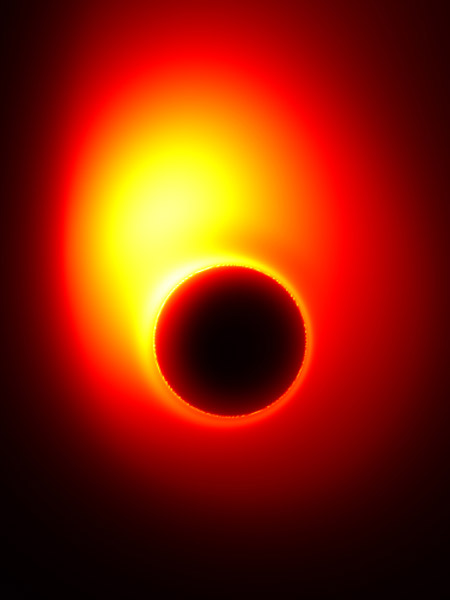
Avery E. Broderick/University of Waterloo/Perimeter Institute
Black holes have a bit of an image problem. That’s to be expected from an immense remnant of a stellar explosion with billions of times the mass of the sun and a gravitational pull so powerful, not even light can escape. Anything that ventures too close gets swallowed whole, never to be seen again. Or so the popular thinking goes. But there’s a dramatic exception to that ironclad rule: all over the cosmos, galaxies with black holes at their center produce powerful energy jets, or blasts of superheated gas and dust that erupt from the very matter swirling down into the hole and travel outward for hundreds of thousands of light-years.
Astronomers have cataloged thousands of such energy jets over the decades, but what they’ve never been able to figure out is what powers them. How can material that effectively circles the galactic drain suddenly wrest itself free, and with such titanic force? Now, thanks to a study by an international team of astrophysicists that was published in the journal Science, there appears to be an answer — one that helps explain not only how the galactic pyrotechnics are produced but also how galaxies themselves grow and expand.
(MORE: A Just-Right Black Hole Fills a Cosmic Void)
What astronomers — with a little help from Albert Einstein — already understand is that every black hole is surrounded by what’s called an event horizon, a threshold at which matter reaches a point of no return. It may be impossible to see the black hole itself, but with the right instruments you can detect the matter at the last moment before it disappears and, in effect, measure and mark the presence of the hole by the very absence it produces. Material at the event horizon forms a so-called accretion disk, a concentrated swirl of dust and gas that orbits the hole at nearly the speed of light, gradually feeding itself inward. It’s at that point that, well, something happens to produce the jets. But what?
(PHOTOS: Window on Infinity: Pictures from Space)
To find out, a team led by Sheperd Doeleman, an astrophysicist at MIT’s Haystack Observatory, focused on a jet bursting from a black hole at the center of the M87 elliptical galaxy, 54 million light-years from the Milky Way. That jet, studied since the early 1900s and among the closest within viewing range, also happens to emanate from a black hole with a highly visible event horizon — mostly because M87 ranks among the sky’s brightest deep-space objects, meaning there are plenty of light emissions reflecting off the debris in the accretion disk.
That doesn’t mean the disk can be studied with any detail, however. Black holes are very small objects on a cosmic scale, and 58 million light-years is still 58 million light-years. To sharpen their resolution, Doeleman and his team thus used a method known as Very Long Baseline Interferometry (VLBI), in which multiple radio telescope dishes collect wave emissions from different perspectives and later align them into measurement data, much as the mirror and lens on a standard telescope aligns light waves into an image. “It’s a specialized thoroughbred technique which gives us the highest amount of detail of anything available to astronomers,” says Doeleman. For their study, they used data from radio dishes in Arizona, California and Hawaii, combining them in such a way that the observatories acted as a single, massive instrument with a resolution 2,000 times that of the Hubble Space Telescope. That revealed a lot.
(MORE: The Blackest Black Hole: Scientists Find a Monster the Size of 21 Billion Suns)
M87’s event horizon, the researchers learned, is about the size of our solar system. The matter that produces the jets appears to come from an orbital position near the innermost edge of the accretion disk, about 5.5 times as distant as the horizon itself. That seems remote, but according to Einstein’s gravitational theories, it’s the last possible point at which matter can move in a stable orbit, because space time is distorted near a black hole. It’s also the birthing ground for the jets, possibly because magnetic fields embedded in the material that’s circling near the hole become twisted, carrying energy away in the form of an electromagnetic blast that is filled with charged particles — the very charged particles that emit the radio waves the scientists collected from Earth for their study.
The M87 jet’s tight orbit fits only one theoretical model of black-hole dynamics, one that suggests that gravity from the swirling accretion disk can rotate a black hole over time, causing both to spin in the same direction and drawing the innermost orbit into the range where the astronomers found the M87 jet. That supports years of conjecture that black holes are anything but motionless. Says Doeleman: “The black hole has to be spinning to explain those measurements.”
Although the study centers on a single jet, the ramifications extend across the galaxy, since the energy blasts broadly distribute matter and energy, feeding and disrupting star formation. Astronomers therefore hope their next look at the jets’ launch pad will be even more detailed. They plan on expanding their telescope array to include radio dishes worldwide, increasing the sensitivity of their virtual telescope by a factor of 10 and possibly leading to images rather than just measurements. As good as the high-speed energy jets are at escaping black holes, avoiding astronomers’ prying eyes will — with luck — prove much more difficult.
PHOTOS: Snapshots of the Heavens: Amazing Astronomy Images
MORE: Scientists Hear a Star’s ‘Screams’ as It’s Devoured by a Black Hole

